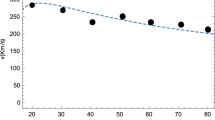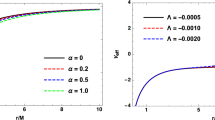Abstract
We impose Neumann boundary condition to solve cosmological perturbation equations and we derive a modified Friedmann equation and a new lensing equation. To check the new lensing equation and the value of Neumann constant, a sample that contains ten strong lensing systems is surveyed. Except for one lens, masses of the other lenses are found to be within the constrains of the observational data. Furthermore, we argue that by using the concept of geometrodynamic clocks it is possible to modify the equation of motion of massive particles too. Also, a sample that includes 101 HSB and LSB galaxies is used to re-estimate the value of the Neumann constant and we found that this value is consistent with the prior evaluation from Friedmann and lensing equations. Finally, the growth of structure is studied by a Newtonian approach which resulted in a more rapid rate of the structure formation in matter dominated era.






Similar content being viewed by others
References
Anderson, J.L.: Phys. Rev. Lett. 75, 3602 (1995)
Arfken, G.B., Weber, H.-J., Harris, F.E.: Mathematical Methods for Physicists: A Comprehensive Guide. Academic Press, San Diego (2012)
Bamba, K., Capozziello, S., Nojiri, S., Odintsov, S.D.: Astrophys. Space Sci. 342(1), 155–228 (2012)
Bardeen, J.M.: Phys. Rev. D 22, 1882–1905 (1980)
Begeman, K.G., Broeils, A.H., Sanders, R.H.: Mon. Not. R. Astron. Soc. 249, 523 (1991)
Behar, S., Carmeli, M.: Int. J. Theor. Phys. 39, 1397–1404 (2000). arXiv:astro-ph/9907244
Bonnor, W.B.: Class. Quantum Gravity 16, 1313 (1999)
Brahm, D.E., Gruber, R.P.: Gen. Relativ. Gravit. 24(3), 297–303 (1992)
Brownstein, J.R., Moffat, J.W.: Astrophys. J. 636(2), 721–741 (2006)
Carmeli, M.: In: Nuclear Physics B Proceedings Supplements, vol. 124, pp. 258–263 (2003). arXiv:astro-ph/0205113
Carroll, S.M.: Spacetime and Geometry. Addison-Wesley, Reading (2004)
Castagnino, M.A.: J. Math. Phys. 12, 2203 (1971)
CASTLES Survey (2015). www.cfa.harvard.edu/castles/
Chabrier, G.: Publ. Astron. Soc. Pac. 115(809), 763–795 (2003)
Chiu, M.-C., Ko, C.-M., Tian, Y., Sheng Zhao, H.: Phys. Rev. D 83, 063523 (2011)
Cooperstock, F.I., Faraoni, V., Vollick, D.N.: Astrophys. J. 503, 61 (1998)
de Blok, W.J.G., McGaugh, S.S.: Astrophys. J. 469, L89 (1996)
Desloge, E.A.: Gen. Relativ. Gravit. 21(7), 677–681 (1989)
Dicke, R.H., Peebles, P.J.E.: Phys. Rev. Lett. 12, 435 (1964)
Einstein, A., Straus, E.G.: Rev. Mod. Phys. 17, 120 (1945)
Famaey, B., McGaugh, S.S.: Modified Newtonian dynamics (MOND): observational phenomenology and relativistic extensions. Living Rev. Relativ. 15, 10 (2012). http://www.livingreviews.org/lrr-2012-10
Faraoni, V., Jacques, A.: Phys. Rev. D 76, 063510 (2007)
Farrar, G.R., Rosen, R.A.: Phys. Rev. Lett. 98, 171302 (2007). doi:10.1103/PhysRevLett.98.171302
Hartnett, J.G.: Int. J. Theor. Phys. 44(3), 359–372 (2005). arXiv:gr-qc/0407082
Hubble, E.: Proc. Natl. Acad. Sci. USA 15(3), 168–173 (1929)
Jacobs, M.W., Linder, E.V., Wagoner, R.V.: Phys. Rev. D 45, 10 (1992)
Marzke, R.F., Wheeler, J.A.: Gravitation as geometry-I. In: Chiu, H.Y., Hoffman, W.F. (eds.) Gravitation and Relativity. Benjamin, New York (1964)
McVittie, G.C.: Mon. Not. R. Astron. Soc. 93, 325 (1933)
Milgrom, M.: Astrophys. J. 270, 365–370 (1983a)
Milgrom, M.: Astrophys. J. 270, 371–383 (1983b)
Milgrom, M.: Astrophys. J. 270, 384–389 (1983c)
Misner, C.W., Thorne, K.S., Wheeler, J.A.: Gravitation. Freeman, New York (1973)
Mukhanov, V.: Physical Foundations of Cosmology. Cambridge University Press, Cambridge (2005)
OB́rien, J.G., Mannheim, P.D.: Mon. Not. R. Astron. Soc. 421, 1273–1282 (2012)
Ohanian, H.C.: Gravitation and Spacetime. Norton, New York (1976)
Pachner, J.: Phys. Rev. 132, 1837 (1963)
Pachner, J.: Phys. Rev. B 137, 1379 (1965)
Pyne, T., Birkinshaw, M.: Astrophys. J. 458, 46–56 (1996)
Romanowsky, A.J., Douglas, N.D., Arnaboldi, M., Kuijken, K., Merrifield, M.R., Napolitano, N.R., Capaccioli, M., Freeman, K.C.: Science 301, 1696 (2003)
Salpeter, E.E.: Astrophys. J. 121, 161 (1955)
Sanders, R.H.: Astrophys. J. 473, 117 (1996)
Shenavar, H.: (2016, in preparation)
Sofue, Y.: Astrophys. J. 458, 120 (1996)
Spergel, D.N., Flauger, R., Hložek, R.: Phys. Rev. D 91, 023518 (2015)
Verheijen, M.A.W., Sancisi, R.: Astron. Astrophys. 370, 765 (2001)
Zhao, H., Bacon, D., Taylor, A., Horne, K.: Mon. Not. R. Astron. Soc. 368(1), 171–186 (2006)
Acknowledgements
I would like to thank the authors Mu-Chen Chiu, Chung-Ming Ko, Yong Tian, HongSheng Zhao, David J. Bacon, Andy N. Taylor, Keith Horne, J.R. Brownstein and J.W. Moffat for providing their data freely. Also, I thank Mahmood Roshan and Koroush Javidan for very useful discussions. I acknowledge the anonymous reviewer whose comments helped to improve and clarify this manuscript. The section on the growth of structures is added due to reviewer’s suggestion. This research has made use of NASA’s Astrophysics Data System.
Author information
Authors and Affiliations
Corresponding author
Appendix: deriving Friedmann equations
Appendix: deriving Friedmann equations
In Sects. 2 and 3 we derived the first order equations of Einstein field and we showed that, assuming Neumann BC, we find a new term in the equation of motion. This new term contributes in the total amount of the energy of the field. Having this point in mind, now we will obtain the perfect-fluid energy—momentum tensor of a collection of particles with velocities distributed isotropically by finding the average values at large scales. The energy-momentum tensor of a system of discrete point particles has the form of \(\varSigma_{a}\frac {p^{a}_{ \mu}p^{a}_{\nu}}{p^{a}_{0}} \delta(\vec{x}-\vec{x^{a}})\) in which \(p_{\mu}^{a}\) and \(\vec{x^{a}}\) show four-momentum and the position of particle \(a\) respectively. See Carroll (2004, page 47). We use this more general formula to include the fact that small amounts of matters \(\rho^{\prime} \) might be in moving and so have a pressure in bulk; otherwise, it was simple to find the average of \(\rho^{\prime} \) at large scales which is equal to \(\rho\). In general, any arbitrary tensor at large scales like \(B_{\mu\nu} \) could be found by averaging its small scale counterpart \(b_{\mu\nu} \) over 4-volumes
Using this equation plus discrete point particles energy-momentum tensor and noticing that the determinant of the flat FRW metric \(g\) only depends to time we find that the time integration would cancel in the fraction. Also, by integrating over spatial coordinates which eliminates delta function we arrive at:
in which \(V_{3}\) is the 3-dimensional volume. The 00 component of the energy momentum tensor of a system of discrete point particles is equal to \(\frac{\varSigma_{a} p^{0}_{a}}{V_{3}} = \rho\) while, because of the isotropy, the 0i components are equal to zero. Also due to isotropy there could be no distinguished direction in the space and so the ij components should form a totally degenerate tensor as \(P\delta_{ij}\). Clearly, pressure at large scale P represent the average value of pressure in small scale p which we introduced in Eq. (16).
Now, we should include the local energy of the new term due to Neumann BC too and formally define the energy-momentum tensor at large scales \({}^{0}T_{\mu\nu}\). We extract terms proportional to \(c_{1}\) from \(G_{00}\) and \(G_{ii}\) components of Einstein tensor (13) and insert them into the right hand side of the Einstein field to obtain:
where “diag” means a diagonal matrix. By solving zero-order Einstein equation with a cosmological constant \({}^{0}R_{\mu\nu}-1/2 {}^{0}R g_{\mu\nu} + \varLambda g_{\mu\nu}= 8\pi G {}^{0}T_{\mu\nu}\) we derive the next two modified Friedmann equations:
In Sect. 4, we used the first of these two equations to estimate the value of \(c_{1}\) and derive the angular distance function in our cosmological model. The appearance of the new term is due to two of our assumptions. First, our metric is not exactly FRW metric but a perturbation metric is added to that too. Second, we assumed a new boundary condition to solve perturbation equations. The second equation which contains \(\ddot{R}\) could be more simplified by using the first one as:
We see that if we put \(c_{1}=0 \) we can derive the usual Friedmann equations and therefore, our model reproduces prior results.
Rights and permissions
About this article
Cite this article
Shenavar, H. Imposing Neumann boundary condition on cosmological perturbation equations and trajectories of particles. Astrophys Space Sci 361, 93 (2016). https://doi.org/10.1007/s10509-016-2676-5
Received:
Accepted:
Published:
DOI: https://doi.org/10.1007/s10509-016-2676-5




